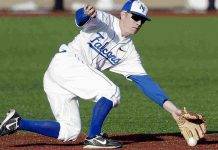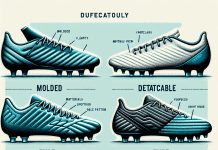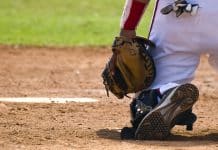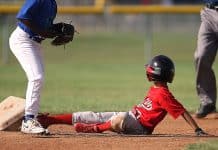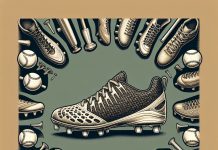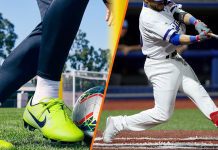In the exciting world of baseball, having the right gear can make all the difference. One crucial piece of equipment that players often overlook is their choice of cleats. Choosing the right pair of cleats can enhance your performance on the field, providing the traction and stability needed to sprint, slide, and pivot confidently.
With so many options available, it’s essential to consider factors such as surface type, player position, and comfort. This article will explore the different types of cleats and help you find the perfect pair to elevate your game.
Factors to Consider when Choosing Baseball Cleats
When it comes to choosing the right baseball cleats, there are several factors you should consider. These factors can significantly impact your performance on the field and ensure that you have a comfortable and safe experience. Here are the key factors to keep in mind:
Review contents
Playing Surface
One of the most important factors to consider when choosing baseball cleats is the playing surface you will be playing on. Different cleat styles are designed for specific surfaces to optimize traction and performance. The four main playing surfaces to consider are grass fields, artificial turf, dirt or clay fields, and indoor or turf fields. Each surface has unique demands, and selecting the appropriate cleat type will significantly enhance your performance.
Traction
Traction is crucial in baseball as it allows you to accelerate quickly, make sharp turns, and maintain stability during plays. The type and configuration of the cleat studs significantly impact traction. Metal cleats provide excellent traction on most surfaces, especially soft ground. Molded cleats, on the other hand, offer good traction on a variety of surfaces but may not be as effective on softer ground. Turf shoes provide optimal traction on artificial turf and indoor surfaces, ensuring you have a firm grip without damaging the playing surface.
Weight and Comfort
Baseball cleats come in various weights, and finding the right balance between weight and comfort is essential. Lightweight cleats can enhance your speed and agility on the field but may not offer as much cushioning or support as heavier options. Comfort is equally important since you’ll spend hours on your feet during practices and games. Look for cleats with cushioned midsoles, breathable materials, and adequate arch and heel support to ensure optimal comfort throughout the game.
Ankle Support
Ankle injuries are common in baseball, and proper ankle support can significantly reduce the risk of these injuries. When choosing cleats, consider the level of ankle support they provide. High-top cleats offer maximum ankle support and stability, making them suitable for players with a history of ankle injuries or needing additional support. Low-top cleats, on the other hand, allow for greater mobility and flexibility but may provide less support. Some cleats also come with ankle straps that can add extra stability and support for players who prefer low-top cleats.
Durability
Durability is an essential factor to consider when investing in baseball cleats. The upper material, stitching, outsole material, and reinforcements all contribute to the overall durability and longevity of the cleats. Look for cleats made from high-quality materials that can withstand the rigors of the game. Reinforcements in high-wear areas, such as the toe and sides, can prolong the lifespan of the cleats. Proper maintenance, such as cleaning and storing the cleats correctly, can help preserve their durability.
Fit
The fit of your baseball cleats can significantly impact your performance and prevent discomfort or injury. Finding the perfect fit involves considering sizing, width, break-in period, trial and testing, and arch type. Proper sizing ensures that your cleats fit snugly without being too tight or loose. It’s also essential to consider the width, as some cleats are designed to accommodate different foot widths. Breaking in your cleats before wearing them in games can help ensure a comfortable fit. Additionally, trying on and testing different options can help you find the best cleats for your feet. Lastly, considering your arch type can help you choose cleats with the proper arch support.
Price
Price is another factor to consider when choosing baseball cleats. While sticking to your budget is essential, finding a balance between price and quality is crucial. Investing in a higher-quality pair of cleats may enhance performance, durability, and comfort. However, there are also affordable options available that offer good performance and value for money. Consider your needs, play frequency, and budget to make the best decision for yourself.
Brand and Design
While not as crucial as factors like traction or comfort, the brand and design of your baseball cleats can still influence your choice. Some players have brand preferences based on past positive experiences or endorsements by professional athletes. The design aspect may also be a factor if you value aesthetics or if your team has specific color requirements. Ultimately, the brand and design should be secondary to factors directly impacting performance and comfort.
League Regulations
Before purchasing baseball cleats, it’s essential to familiarize yourself with any league regulations that may govern the type or design of cleats allowed. Some leagues may have strict rules regarding metal cleats, molded cleats, or certain stud types. Check with your coach or league officials to ensure your cleats comply with regulations.
Personal Preference
Lastly, personal preference plays a significant role when choosing baseball cleats. Each player’s needs and preferences are unique, and finding cleats that align with your playing style and personal comfort is crucial. Consider factors such as your position on the field, your playing style, and any specific requirements you may have. Ultimately, the cleats you feel most comfortable and confident in will be your best choice.
Different Types of Baseball Cleats
Now that we have discussed the various factors to consider when choosing baseball cleats let’s explore the different types of cleats available. Understanding the pros and cons of each type will help you make an informed decision based on your specific needs and playing conditions.
Metal Cleats
Metal cleats, also known as spikes, are popular among baseball players due to their outstanding traction and performance on grass fields. They feature metal studs that can dig deep into the ground, providing excellent grip and stability. Metal cleats are particularly beneficial for players who need maximum traction during quick turns and sprints. However, it’s important to note that metal cleats are generally not allowed in youth leagues or some recreational leagues due to safety concerns.
Molded Cleats
Molded cleats are versatile and suitable for most playing surfaces. They feature rubber or plastic studs permanently attached to the shoe’s outsole. Molded cleats provide good traction on various surfaces, including grass, dirt, and artificial turf. They are often more comfortable and lightweight than metal cleats, making them popular for players of all ages and skill levels. Molded cleats are also generally more affordable than metal cleats.
Turf Shoes
Turf shoes, as the name suggests, are designed specifically for artificial turf surfaces. They feature a flat rubber outsole that maximizes traction without damaging the turf. Turf shoes are ideal for players who primarily play on artificial turf fields or indoor facilities. They offer excellent grip, comfort, and flexibility, making them a popular choice among players in these conditions. However, due to their specialized design, turf shoes may not perform as well on other surfaces, such as grass or wet.
Multi-sport Cleats
Multi-sport cleats are designed to be versatile for various athletic activities, including baseball. They often feature a hybrid design that combines elements of both molded and turf shoes. Multi-sport cleats typically have removable studs or a combination of different stud types, allowing you to adapt the shoe to different playing surfaces. These cleats can be a convenient option if you participate in different sports or have a varied playing schedule that involves different surfaces.
Comparison: Metal Cleats vs Molded Cleats
Now that we have explored the different types of baseball cleats, let’s compare the advantages and disadvantages of metal and molded cleats. This comparison will help you determine which type of cleat best suits your needs and playing conditions.
Advantages of Metal Cleats
- Superior traction: Metal cleats provide exceptional traction on grass fields, especially in wet conditions.
- Enhanced performance: The deep penetration of metal studs allows for quick acceleration, sharp turns, and excellent stability.
- Durability: Metal cleats typically last longer than molded cleats due to their sturdy construction and ability to withstand rough conditions.
- Easy maintenance: The metal studs are easy to clean and maintain, ensuring optimal performance.
Disadvantages of Metal Cleats
- Safety concerns: Metal cleats can pose a safety risk to players, especially in contact-based sports. They can cause injury to other players during collisions or slides.
- Restricted usage: Many youth leagues, recreational leagues, or certain playing surfaces prohibit using metal cleats due to the potential for ground damage.
- Uncomfortable on hard surfaces: Metal cleats may feel uncomfortable on surfaces like concrete or indoor facilities, making them less versatile in certain playing conditions.
Advantages of Molded Cleats
- Versatility: Molded cleats suit various playing surfaces, including grass, dirt, and artificial turf.
- Comfort: Molded cleats are more comfortable right out of the box, requiring a minimal break-in period.
- Wide availability: Molded cleats are readily available and often more affordable than metal cleats.
- Safety: Compared to metal cleats, molded cleats pose a lower risk of injury to other players during contact plays.
Disadvantages of Molded Cleats
- Traction limitations: While molded cleats offer good traction on different surfaces, they may not provide the same level of grip as metal cleats on soft or wet ground.
- Durability: Molded cleats may not be as durable as metal cleats, as the rubber or plastic studs attached to the outsole can wear down over time.
- Restricted usage: Some leagues or playing surfaces may have regulations that limit the use of molded cleats. You must check with your coach or league officials for any restrictions.
Choosing Baseball Cleats Based on Playing Surface
The surface you will be playing on is crucial when selecting the right baseball cleats. Each playing surface has unique demands and requires a specific cleat type to optimize performance and minimize the risk of injury. Let’s explore the different playing surfaces and the recommended cleat types.
Grass Fields
Grass fields are baseball’s most common playing surface, and most games are played on natural grass. For grass fields, both metal cleats and molded cleats are suitable options. Metal cleats provide excellent traction on grass, especially in wet conditions, allowing you to make quick turns and accelerations confidently. However, it’s important to note that some leagues or playing facilities may restrict the use of metal cleats. In such cases, molded cleats provide a reliable alternative, offering good traction and durability on grass surfaces.
Artificial Turf
Artificial turf has become increasingly popular in recent years, as it offers consistent playing conditions and requires less maintenance than natural grass. It’s best to use turf shoes specifically designed for this type of surface when playing on artificial turf. Turf shoes feature a unique flat rubber outsole that provides excellent grip on artificial turf without causing damage. They offer optimal traction, comfort, and stability, allowing you to perform at your best. Using metal or molded cleats on artificial turf can result in excessive wear and may damage the playing surface.
Dirt or Clay Fields
Dirt or clay fields are mainly used for baseball infields, including the pitcher’s mound, bases, and base paths. Molded cleats are the most suitable choice when playing on dirt or clay surfaces. The rubber or plastic studs on molded cleats allow good traction on these surfaces without causing damage. Unlike metal, molded cleats won’t dig too deep into the ground, which can be advantageous when running on the infield or making quick movements. Molded cleats provide the necessary traction while allowing smooth transitions between dirt and grass areas.
Indoor or Turf Fields
Indoor facilities or specific turf fields may require specialized cleats for these surfaces. In such cases, turf shoes are the preferred option. Turf shoes feature a flat rubber outsole that provides optimal traction on indoor surfaces, such as synthetic turf or carpeted areas. They offer adequate grip and stability without causing damage to the floor or artificial turf. The unique design of turf shoes ensures that you can perform at your best without compromising traction or safety.
Wet Conditions
Playing in wet conditions, such as after rain or early morning dew, can present challenges when it comes to traction. In such conditions, metal cleats can offer a significant advantage as their studs dig deep into the soft ground, providing superior grip and stability. The metal studs prevent slippage and allow you to maintain control during quick movements. Molded cleats and turf shoes may struggle to provide the same traction on wet surfaces, potentially resulting in slips or reduced performance. However, it’s essential to ensure that the use of metal cleats is permitted by your league or playing facility, as safety considerations may restrict their usage.
Considerations for Traction
Traction is a crucial aspect of baseball cleats, as it directly affects your ability to accelerate, change directions, and maintain stability on the field. The right amount and configuration of studs can significantly enhance your performance and help prevent slips or falls. Here are some key considerations when it comes to traction:
Studs
The studs on baseball cleats are the primary element responsible for providing traction. The studs’ length, shape, and material greatly influence their performance on different surfaces. Longer studs generally provide better grip on softer ground, such as grass or wet conditions. Shorter studs are more suitable for complex surfaces like artificial turf or dirt. The material of the studs can vary between metal, rubber, or plastic. Metal studs offer exceptional traction on grass but may be prohibited in certain leagues or playing facilities due to safety concerns. Rubber or plastic studs are commonly found on molded cleats, providing good traction on various surfaces. Turf shoes, on the other hand, feature a flat rubber outsole that provides optimal grip on artificial turf and indoor surfaces.
Number and Configuration of Studs
The number and configuration of studs on baseball cleats can also impact traction. Cleats with more studs spread across the outsole tend to provide better traction and stability. This is especially important for positions that require quick direction changes, such as infielders or outfielders. Cleats with more studs can distribute the weight and pressure more evenly, preventing slips or sudden shifts. However, finding the right balance is essential, as too many studs can make the cleat feel less flexible or uncomfortable.
Interchangeable Cleats
Some cleats offer the option to interchange studs, allowing you to customize the cleat configuration based on the playing conditions. This feature can be handy if you frequently play on different surfaces or need to adapt to changing weather conditions. Interchangeable cleats typically come with multiple stud options, such as metal, rubber, or plastic. Depending on your preference or the playing surface, you can select the appropriate studs and swap them out. This versatility can provide an added advantage and ensure optimal traction in various conditions.
Agility and Quickness
Finding cleats that offer exceptional traction is crucial for players who rely on agility and quickness in their movements. Quick acceleration, sudden stops, and sharp turns are standard in baseball, especially for positions like outfielders or base stealers. Cleats that provide excellent traction on soft and hard ground can enhance these quick movements, allowing you to maintain speed and agility without sacrificing stability. Metal cleats, in particular, offer superior traction and are often favored by players who prioritize speed and quickness.
Performance on Different Surfaces
Consider how the cleats perform on different surfaces and whether they meet the specific demands of your playing conditions. While some cleats excel in grass or wet conditions, they may not perform as well on artificial turf or hard surfaces. Assessing the playing surfaces you frequently encounter and choosing cleats that provide reliable traction in those conditions will enhance your overall performance. Understanding the limitations of particular cleats on specific surfaces can help you make informed decisions and avoid potential slips or injuries.
Weight and Comfort
The weight and comfort of baseball cleats play a vital role in your overall performance and level of comfort on the field. The right balance between weight and comfort can significantly impact your speed, agility, and endurance during games. Here are some factors to consider when it comes to weight and comfort:
Materials
Baseball cleats can be constructed from various materials, each offering different benefits in terms of weight and comfort. Common materials used for the upper portion of cleats include leather, synthetic materials, or a combination of both. Leather is known for its durability and natural breathability, providing a comfortable and secure fit. On the other hand, synthetic materials offer lighter weight, flexibility, and sometimes enhanced water resistance. Consider your preferences, playing conditions, and budget when selecting the material for your cleats.
Construction
The construction of the cleats can significantly impact weight and comfort. Cleats with seamless or well-designed overlays reduce the risk of pressure points or discomfort. Pay attention to details such as cushioning, padding, and overall fit. Cleats with well-padded midsoles and collars can enhance comfort during long hours of play, reducing the risk of blisters or foot fatigue. Cleats with breathable materials also allow air circulation and prevent overheating, keeping your feet cool and comfortable.
Midsole Cushioning
Midsole cushioning is an essential feature to consider regarding comfort and shock absorption. The midsole sits between the outsole and insole and helps absorb impact during running, jumping, or sudden stops. Baseball cleats with adequate midsole cushioning can minimize the strain on your feet and joints, reducing the risk of injuries and fatigue. Look for cleats with responsive cushioning that provide comfort and support throughout the game.
Breathability
Baseball is a physically demanding sport that can lead to sweating and discomfort, especially during hot weather or intense games. Cleats with breathable materials, such as mesh panels or perforations, allow air circulation and help wick away moisture from your feet. This improves overall comfort and prevents odor-causing bacteria from forming. Breathable cleats can be particularly beneficial during extended practices or doubleheader games when your feet are subjected to prolonged wear and moisture buildup.
Arch and Heel Support
Proper arch and heel support are essential for overall comfort and preventing common foot issues, such as arch fatigue or plantar fasciitis. Cleats with adequate arch support can provide stability and alignment, reducing strain on your feet and improving overall performance. Cushioned insoles and heel cups can also improve shock absorption and support. Consider your foot type and any specific arch or heel support needs you may have when choosing cleats. Custom insoles or orthotics can also be inserted into specific cleats to provide additional support.
Importance of Ankle Support
Ankle injuries are common in baseball, with lateral movements and sudden direction changes significantly straining the ankles. Proper ankle support is crucial in preventing sprains and other ankle-related injuries. Here are some factors to consider when it comes to ankle support:
High-Top Cleats
High-top cleats extend above the ankle and provide maximum ankle support and stability. They offer additional protection against ankle sprains and twists, making them a preferred choice for players with a history of ankle injuries or those prioritizing stability over flexibility. High-top cleats offer a snug fit around the ankle, reducing the risk of lateral movement and providing a feeling of security. However, it’s important to note that high-top cleats may limit ankle mobility to some extent, so players who rely heavily on agility and quickness may prefer low-top cleats.
Low-Top Cleats
Low-top cleats sit below the ankle and offer enhanced mobility, flexibility, and freedom of movement. They are favored by players who prioritize agility and quickness, as they provide less restriction around the ankle. Low-top cleats allow for a wide range of motion, enabling quick direction changes and easy footwork. However, it’s essential to recognize that low-top cleats provide less ankle support than high-top cleats. Players with a history of ankle injuries or those requiring additional stability may prefer high-top cleats.
Ankle Straps
Some cleats come with ankle straps, which can be an additional feature to consider for ankle support. Ankle straps provide extra stability and reinforcement around the ankle, minimizing the risk of twists or sprains. They can be particularly beneficial for players who prefer low-top cleats but still desire ankle support. Ankle straps can be adjusted to the desired tightness, allowing for a customized fit and added security.
Durability and Longevity
Investing in durable baseball cleats is essential to prolong their lifespan and ensure consistent performance. Here are some key considerations when it comes to durability and longevity:
Upper Material
The upper material of the cleats significantly affects their durability. Leather is known for its durability and ability to withstand wear and tear. Full-grain leather, in particular, is highly durable and can withstand rough field conditions. While often lighter and more affordable, synthetic materials maybe less durable in the long run. It’s essential to strike a balance between durability and personal preferences when selecting the upper material of your cleats.
Stitching
The stitching on baseball cleats plays a significant role in their durability. Look for cleats with reinforced stitching in critical areas, such as the toe box or sides, as these areas often experience the most stress and wear. Double or triple stitching can provide added strength and prevent premature splitting or separation of the materials. Inspect the cleats for any loose or frayed stitching to ensure they are built to last.
Outsole Material
The outsole is the part of the cleats that directly interacts with the playing surface, making its material crucial for performance and durability. Most cleats feature rubber or synthetic outsoles, which offer good durability and traction. Rubber outsoles are more durable and provide better grip, especially on natural grass or dirt surfaces. Synthetic outsoles can be lighter and more flexible but may not offer the same level of durability. Understanding the specific demands of your playing surface and the type of outsole that performs best on it will help you select cleats with optimal durability.
Reinforcements
Cleats with additional reinforcements in critical areas provide enhanced durability and protection. Reinforcements can be in the form of toe caps, overlays, or reinforced sidewalls. These features can prevent premature wear and tear, protect against abrasions, and prolong the lifespan of your cleats. Consider the demands of your playing position and playing surface to determine the level of reinforcement necessary for your specific needs. Reinforced cleats are particularly beneficial for positions that require frequent slides or lateral movements, such as infielders or catchers.
Maintenance
Proper cleat maintenance can significantly extend their lifespan. After each use, you regularly clean your cleats and remove dirt, grass, or mud that can accumulate and potentially damage the materials. It’s essential to follow any specific cleaning instructions provided by the manufacturer. Additionally, storing your cleats in a cool, dry place and allowing them to dry naturally after each use helps prevent odor, mold, or deformation. By taking good care of your cleats, you can ensure they remain in optimal condition and perform at their best for an extended period.
Finding the Perfect Fit
Achieving the perfect fit when choosing baseball cleats is essential for optimal performance and comfort on the field. Ill-fitting cleats can cause discomfort, blisters, instability, or even injury. Here are some factors to consider when finding the perfect fit:
Sizing
Choosing the correct size is the first step in finding the perfect fit for your baseball cleats. Cleats too tight can restrict movement, cause discomfort, and potentially lead to foot issues. On the other hand, cleats that are too loose can result in instability and lack of control. Carefully measure your feet to determine the appropriate size, and refer to size charts provided by the manufacturer. Remember that different brands may have slight variations in sizing, so it’s essential to try on the cleats before making a final decision.
Width
Wide feet or narrow feet require cleats that accommodate their specific width. Many cleat models are available in different width options, such as regular, wide, or narrow. It’s essential to select cleats that provide a snug fit without feeling too tight or too loose around the width of your feet. If you have wide feet, consider choosing cleats with a wider toe box to provide comfort and room for your feet. Conversely, if you have narrow feet, look for cleats that offer a more secure fit by featuring narrower or adjustable designs.
Break-In Period
Baseball cleats often require a break-in period to conform to your feet and provide optimal comfort. The break-in period allows the cleats to mold to the shape of your feet and soften the materials, preventing discomfort or blisters during games. Wear the cleats for short practice sessions or casual wear during the break-in period before using them in intense games. This lets you gradually adjust to the cleats and identify potential fit or comfort issues early on.
Trial and Testing
Trying on and testing different cleat styles and brands can significantly help find the perfect fit. While size charts and measurements provide a starting point, physically trying on cleats is crucial to assess how they fit your feet accurately. Visit a reputable sporting goods store or try on cleats at team stores if possible. Walk, run, and simulate different movements to evaluate the cleats’ fit, support, and comfort. Testing multiple options allows you to compare and select the best cleats for your feet and playing style.
Arch Type
Understanding your arch type can help you find cleats with the appropriate arch support. There are generally three arches: low, average, and high. Cleats with built-in arch support or removable insoles can accommodate different arch types. Players with low arches may need cleats with more significant arch support to prevent excessive pronation. Those with high arches may require additional cushioning and flexibility. Selecting cleats that match your arch type will help ensure optimal comfort, stability, and performance.
Final Thoughts and Recommendations
Choosing the right baseball cleats is a critical decision that can significantly impact your performance, comfort, and safety. While personal preferences, such as brand and design, may influence your decision to some extent, it’s essential to prioritize factors that directly affect performance and comfort. Here are some final thoughts and recommendations when selecting baseball cleats:
Consider Individual Needs
Each player has unique needs and playing conditions. When choosing cleats, analyze your specific requirements, playing style, position, and foot characteristics. Consider factors such as playing surface, traction, weight and comfort, ankle support, and durability to find the best cleats.
Prioritize Safety and Performance
When selecting baseball cleats, safety should always be a priority. Ensure the cleats comply with league regulations or playing surface requirements to avoid penalties or disqualification. Moreover, prioritize performance-enhancing features such as traction, support, and overall fit. Cleats that offer optimal performance and stability will ultimately contribute to your overall safety during games.
Seek Expert Advice
If you’re unsure which baseball cleats to choose, seek advice from experienced players, coaches, or knowledgeable sales personnel. They can provide valuable insights based on their expertise and experience. Additionally, they may be able to offer recommendations based on your specific needs or preferences.
Try Different Options
Don’t be afraid to try different cleats and experiment with different styles and brands. What works for one player may not work for another. By testing different options, you can find the most comfortable cleats, provide the necessary support, and enhance your performance. Remember to consider traction, weight, comfort, ankle support, and durability factors during your trial and testing process.
Quality over Quantity
When it comes to baseball cleats, choosing quality over quantity is crucial. Investing in a higher-quality pair of cleats may be more expensive upfront, but they will likely offer better performance, durability, and overall value in the long run. High-quality cleats can provide a comfortable and secure fit, allowing you to focus on the game and perform at your best without worrying about discomfort or premature wear.
By carefully considering these factors, exploring the different types of available cleats, and understanding the pros and cons of each, you can make an informed decision when choosing baseball cleats. Remember, finding the right cleats that suit your playing style, fit comfortably, and provide optimal support will significantly enhance your performance and enjoyment of the game. So lace up those cleats, step onto the field, and play your best baseball game yet!



